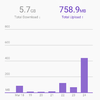Looks like Tesla is more aggressively collecting data for stop signs and/or traffic lights. With the maps/navigation update (5.5GB) yesterday, I tested red light and stop sign warnings, and the car uploaded 0.5GB of data from just a little bit of driving, which seems likely to include video/images.
View attachment 525568
This was with 2020.12, and there's some warning behavior differences from when stop sign warning first became available. It looks like the car now needs to be going fast enough to trigger the warning, e.g., 20mph seems to more consistently trigger than 15mph. (Whereas with the initial release of stop sign warning, I could drop the speed to 5mph and very slowly roll towards the line and trigger the warning.) This has a side benefit of those who reduce the set speed to 0mph for stop lines won't need to hear the warning beeps anymore.



